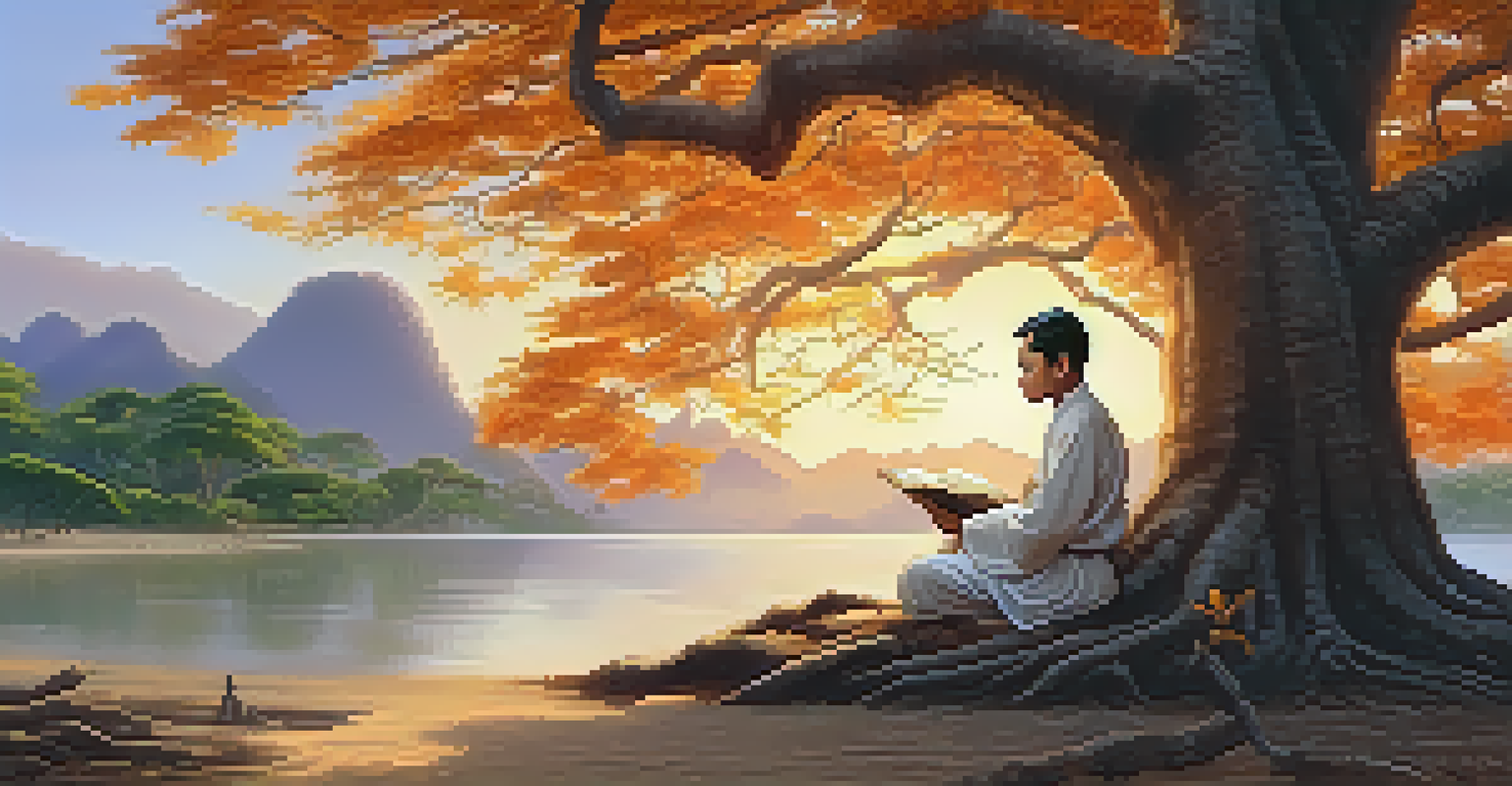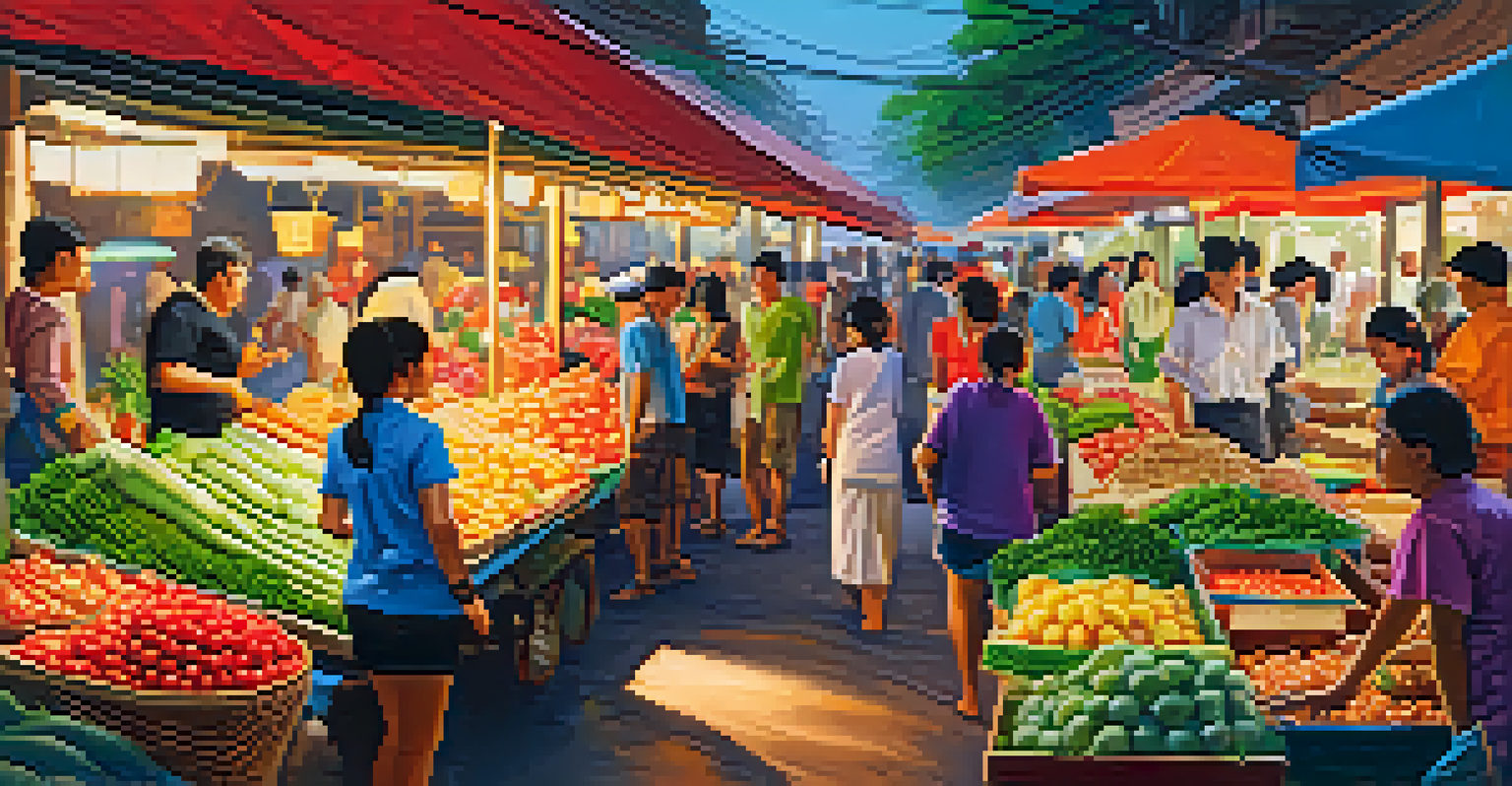The Evolution of Thai Literature from Ancient to Modern Times

The Roots of Thai Literature in Ancient Texts
Thai literature has its roots in ancient times, with texts dating back to the Sukhothai period. These early works were often inscribed on stone or created in the form of poems. The literature reflected the socio-political environment and Buddhist philosophy prevalent during that era, showcasing a blend of spirituality and daily life.
Literature is the most agreeable way of ignoring life.
One of the most notable early texts is the 'Ramakien,' a Thai version of the Indian epic 'Ramayana.' This epic not only tells the story of Rama but also weaves in local culture and beliefs, making it uniquely Thai. Such adaptations were crucial in shaping national identity and literary expression.
As these ancient texts circulated, they laid the foundation for future literary movements, reflecting the evolution of language and storytelling styles in Thai culture. This period marked the beginning of a rich tapestry that would continue to develop over centuries.
The Golden Age: Ayutthaya and Its Literary Flourish
The Ayutthaya period, spanning from the 14th to the 18th century, is often considered a golden age for Thai literature. During this time, the kingdom flourished economically and culturally, which significantly influenced its literary output. Poets and writers began to explore various genres, including drama, poetry, and historical narratives.

One of the hallmark achievements of this era was the 'Phra Aphai Mani,' a poetic epic written by Sunthorn Phu. This work not only entertained but also provided social commentary, highlighting the lives and struggles of the Thai people. Sunthorn Phu is still celebrated today as one of Thailand's greatest poets.
Roots of Thai Literature Explored
Thai literature originated in ancient texts, reflecting the socio-political and spiritual life during the Sukhothai period.
The period also saw the emergence of theatrical performances, which combined literature, music, and dance to tell stories. These performances became a vital part of Thai culture, further enriching the literary landscape and ensuring that storytelling remained a communal experience.
Colonial Influence and Transition in the 19th Century
The 19th century brought significant changes to Thai literature due to colonial influences from Western countries. As Thailand (then known as Siam) faced pressures from colonial powers, writers began to incorporate Western literary styles and themes into their works. This blending of influences marked a critical transition in the evolution of Thai literature.
A book is a dream that you hold in your hand.
King Rama IV and King Rama V played pivotal roles in this literary transformation, promoting education and the printing press. Their reigns saw the introduction of novels and short stories, which allowed for more diverse narratives and characters. This was a departure from traditional forms, marking a shift toward modern literature.
As Western literature gained popularity, Thai authors began to explore themes of national identity, social issues, and individualism. This period set the stage for a richer and more complex literary tradition that would continue to evolve in the years to come.
Modernism and the Rise of Thai Novels in the 20th Century
The 20th century marked a significant turning point in Thai literature with the rise of modernism. Authors began experimenting with narrative techniques and styles, moving away from the structured forms of earlier periods. This era saw the emergence of the modern novel, which allowed writers to delve deeper into the human experience and societal issues.
One prominent figure during this time was Phong Nha, known for his novel 'Khan Kha' which highlighted the struggles of ordinary people. His works often reflected the social changes of the time, addressing themes such as poverty, love, and political unrest. This focus on realism made literature more relatable to the average Thai citizen.
Modernism Transforms Literary Scene
The 20th century brought modernism, allowing Thai authors to explore deeper societal issues through innovative narrative techniques.
Additionally, literary movements began to flourish, fostering a sense of community among writers and readers. This period was characterized by a vibrant exchange of ideas, leading to a rich literary scene that contributed to the evolution of Thai literature as we know it.
Contemporary Thai Literature: Voices of a New Generation
Today, contemporary Thai literature is vibrant and diverse, reflecting the complexities of modern Thai society. Writers are exploring various genres, including fiction, poetry, and memoirs, often addressing pressing social issues like gender, politics, and identity. This openness to experimentation allows for a wide range of voices to be heard.
Notable contemporary authors such as Veeraporn Nitiprapha and Chira Chote have gained international recognition, bringing Thai literature to a global audience. Their works often blend traditional storytelling with modern themes, creating a unique narrative that resonates with readers both in Thailand and abroad.
Moreover, the rise of digital publishing and social media has given a platform to emerging writers, fostering a new literary community. This accessibility encourages fresh perspectives and innovative storytelling, ensuring that Thai literature continues to evolve and thrive in the modern age.
The Role of Translation in Expanding Thai Literature's Reach
Translation plays a crucial role in broadening the reach of Thai literature beyond its borders. As more works are translated into various languages, international readers can discover the rich narratives and cultural insights embedded in Thai storytelling. This exchange not only promotes Thai literature but also fosters cross-cultural understanding.
Organizations and literary festivals have been established to support translators and promote Thai authors globally. These initiatives aim to bridge the gap between different cultures, allowing Thai voices to resonate in diverse literary landscapes. This growing interest in Thai literature has led to a surge in translations of both classic and contemporary works.
Translation Expands Global Reach
Translation plays a key role in making Thai literature accessible to international audiences, fostering cultural exchange and understanding.
Through translation, themes of love, loss, and resilience found in Thai literature become universal. This not only enhances the global literary scene but also enriches the cultural tapestry, showcasing the beauty of Thai storytelling to the world.
The Future of Thai Literature: Trends and Innovations
As we look to the future, Thai literature is poised for continued growth and innovation. With the advent of technology, new mediums such as e-books and audiobooks are reshaping how literature is consumed. This digital transformation opens up exciting possibilities for writers to reach a wider audience and experiment with narrative forms.
Emerging themes in Thai literature often reflect the rapid changes in society. Issues such as climate change, urbanization, and social justice are becoming central to many contemporary narratives. As authors grapple with these challenges, their works resonate with a generation seeking to understand and address pressing global issues.

Furthermore, the blending of traditional and modern storytelling techniques is likely to continue, fostering a unique literary identity. The future of Thai literature is bright, with a diverse array of voices ready to shape its next chapter, ensuring that it remains a vital part of the cultural landscape.